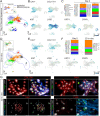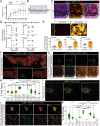Mapping the adult human esophagus in vivo and in vitro
- PMID: 36278875
- PMCID: PMC9720751
- DOI: 10.1242/dev.200614
Mapping the adult human esophagus in vivo and in vitro
Abstract
Many esophageal diseases can arise during development or throughout life. Therefore, well-characterized in vitro models and detailed methods are essential for studying human esophageal development, homeostasis and disease. Here, we (1) create an atlas of the cell types observed in the normal adult human esophagus; (2) establish an ancestrally diverse biobank of in vitro esophagus tissue to interrogate homeostasis and injury; and (3) benchmark in vitro models using the adult human esophagus atlas. We created a single-cell RNA sequencing reference atlas using fresh adult esophagus biopsies and a continuously expanding biobank of patient-derived in vitro cultures (n=55 lines). We identify and validate several transcriptionally distinct cell classes in the native human adult esophagus, with four populations belonging to the epithelial layer, including basal, epibasal, early differentiating and terminally differentiated luminal cells. Benchmarking in vitro esophagus cultures to the in vivo reference using single-cell RNA sequencing shows that the basal stem cells are robustly maintained in vitro, and the diversity of epithelial cell types in culture is dependent on cell density. We also demonstrate that cultures can be grown in 2D or as 3D organoids, and these methods can be employed for modeling the complete epithelial layers, thereby enabling in vitro modeling of the human adult esophagus.
Keywords: In vitro; Adult; Biobank; Esophagus; Fetal; Organoid.
© 2022. Published by The Company of Biologists Ltd.
Conflict of interest statement
Competing interests The authors declare no competing or financial interests.
Figures






Similar articles
-
Functional Characterization and Visualization of Esophageal Fibroblasts Using Organoid Co-Cultures.J Vis Exp. 2023 Jan 6;(191). doi: 10.3791/64905. J Vis Exp. 2023. PMID: 36688545
-
Modeling Epithelial Homeostasis and Perturbation in Three-Dimensional Human Esophageal Organoids.Biomolecules. 2024 Sep 5;14(9):1126. doi: 10.3390/biom14091126. Biomolecules. 2024. PMID: 39334892 Free PMC article.
-
Regionalized cell and gene signatures govern esophageal epithelial homeostasis.Dev Cell. 2025 Jan 20;60(2):320-336.e9. doi: 10.1016/j.devcel.2024.09.025. Epub 2024 Oct 18. Dev Cell. 2025. PMID: 39426382
-
Development and application of human adult stem or progenitor cell organoids.Nat Rev Nephrol. 2015 Sep;11(9):546-54. doi: 10.1038/nrneph.2015.118. Epub 2015 Jul 28. Nat Rev Nephrol. 2015. PMID: 26215513 Review.
-
A critical look: Challenges in differentiating human pluripotent stem cells into desired cell types and organoids.Wiley Interdiscip Rev Dev Biol. 2020 May;9(3):e368. doi: 10.1002/wdev.368. Epub 2019 Nov 19. Wiley Interdiscip Rev Dev Biol. 2020. PMID: 31746148 Free PMC article. Review.
Cited by
-
An esophagus cell atlas reveals dynamic rewiring during active eosinophilic esophagitis and remission.Nat Commun. 2024 Apr 18;15(1):3344. doi: 10.1038/s41467-024-47647-0. Nat Commun. 2024. PMID: 38637492 Free PMC article.
-
IL-13-induced STAT3-dependent signaling networks regulate esophageal epithelial proliferation in eosinophilic esophagitis.J Allergy Clin Immunol. 2023 Dec;152(6):1550-1568. doi: 10.1016/j.jaci.2023.07.021. Epub 2023 Aug 29. J Allergy Clin Immunol. 2023. PMID: 37652141 Free PMC article.
-
Epithelial architecture and signaling activity in the adult human esophagus.Front Cell Dev Biol. 2025 Jul 16;13:1632255. doi: 10.3389/fcell.2025.1632255. eCollection 2025. Front Cell Dev Biol. 2025. PMID: 40741329 Free PMC article. Review.
References
-
- Bailey, D. D., Zhang, Y., van Soldt, B. J., Jiang, M., Suresh, S., Nakagawa, H., Rustgi, A. K., Aceves, S. S., Cardoso, W. V. and Que, J. (2019). Use of HPSC-derived 3D organoids and mouse genetics to define the roles of YAP in the development of the esophagus. Development 146, dev178855. 10.1242/dev.178855 - DOI - PMC - PubMed
-
- Barbera, M., Pietro, M. D., Walker, E., Brierley, C., MacRae, S., Simons, B. D., Jones, P. H., Stingl, J. and Fitzgerald, R. C. (2015). The human squamous oesophagus has widespread capacity for clonal expansion from cells at diverse stages of differentiation. Gut 64, 11-19. 10.1136/gutjnl-2013-306171 - DOI - PMC - PubMed
Publication types
MeSH terms
Grants and funding
LinkOut - more resources
Full Text Sources

